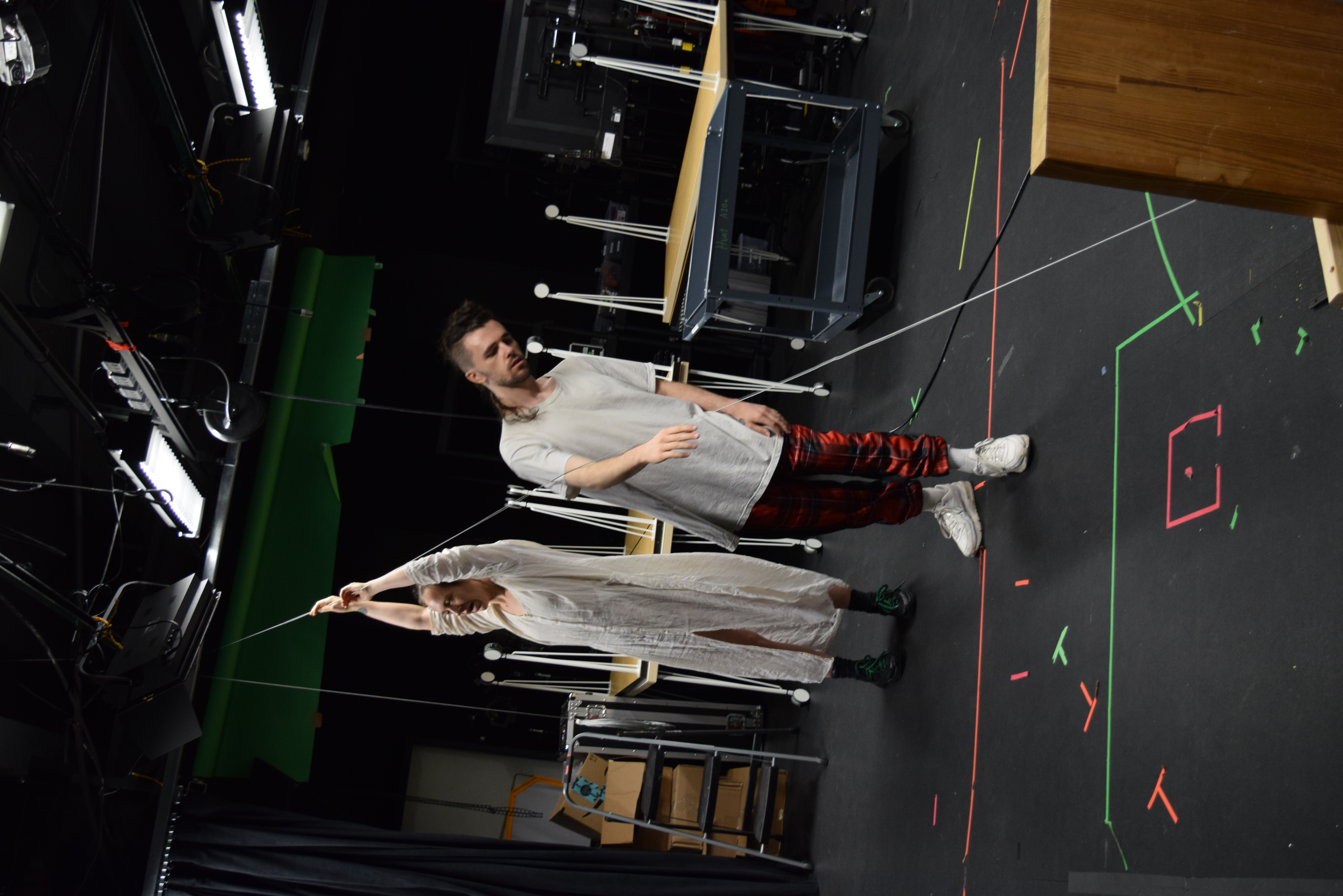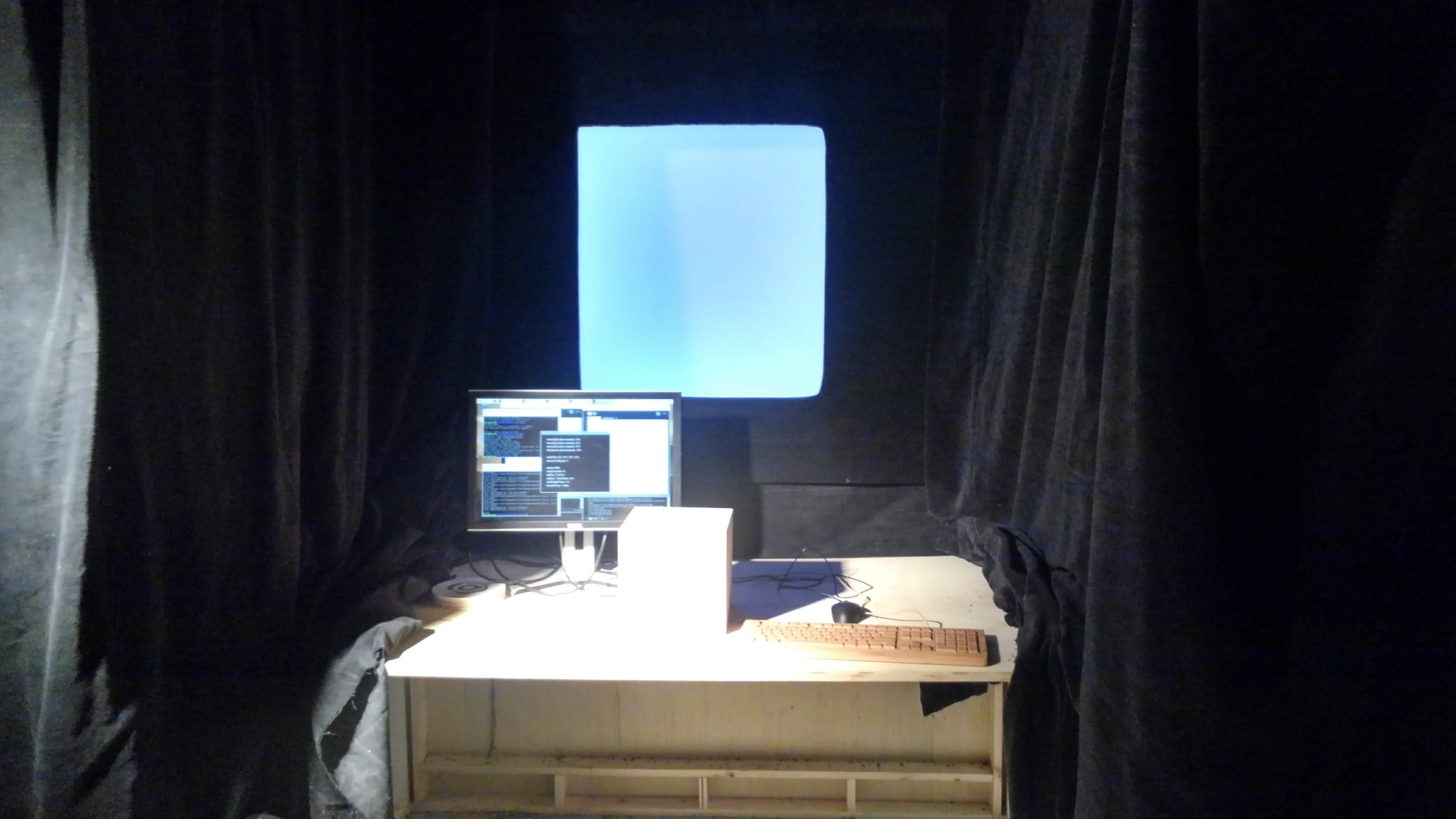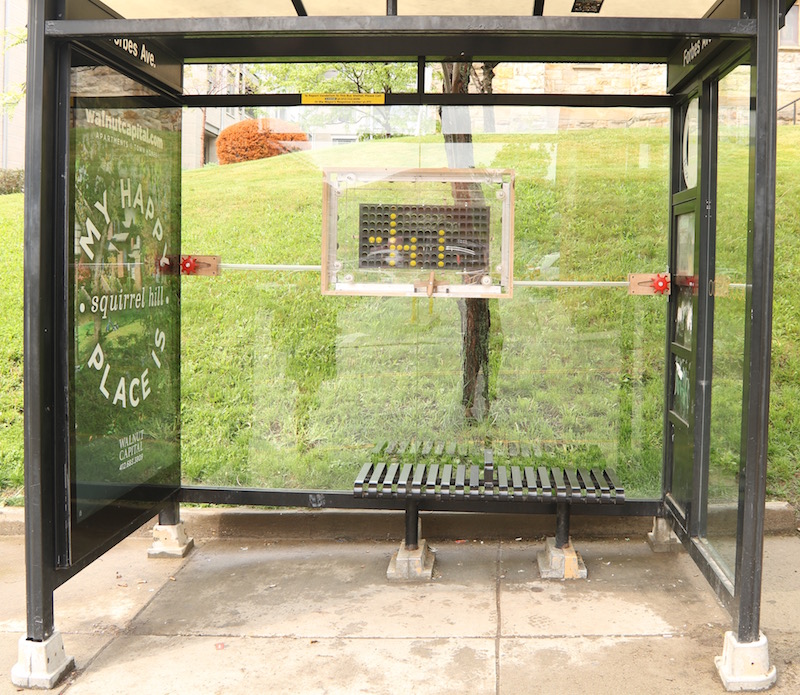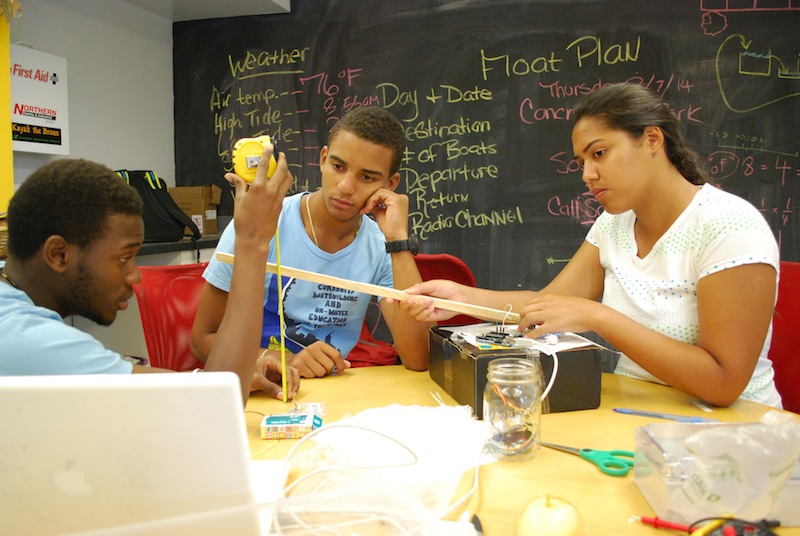Here are some different projects I’ve worked on, listed in reverse chronological order:
Remote Possibilities (2021)
How do you have an interactive dance performance during a pandemic? We explored some answers to this question with Remote Possibilities, an experimental fusion of dance, music, and engaging the audience members’ webcams to do live face and body tracking.
The piece was built in Javascript, starting with a healthy dose of p5.js for lots of prototyping, and culminated in a series of live, remote performances during March of 2021. Performance duo slowdanger turned their living room into a bizarro-world remotely-viewable playspace, Kevin DeLand did the heavy technical lifting, and I helped conceive the piece and put together many experimental iterations of interactive web effects.
Pittsburgh Post-Gazette story: “Slowdanger Delivers Interactive Virtual Dance Experience in ‘Remote Possibilities’”
Built of webcams, open-source face trackers, Javascript, makeup, and colored lights.
 Experimenting with remotely-sourced video with overlays (a pigeon in this case). When the user moved their mouse, the transparent diamond followed it around, which allowed for some peekaboo interactivity.
Experimenting with remotely-sourced video with overlays (a pigeon in this case). When the user moved their mouse, the transparent diamond followed it around, which allowed for some peekaboo interactivity.
 Experimenting with live-sourced video with overlays, this time using our own live video as the source.
Experimenting with live-sourced video with overlays, this time using our own live video as the source.
 A promotional still for the performance.
A promotional still for the performance.
Sample video of face tracking via webcam. I think this was my face, but truly don’t know!
Resonant Bodies (2019)
A tactile speaker. Designed to add an audience-accessible kinesthetic element to a live dance performance, so that people with different physical abilities can participate more fully as audience members.
Installation piece with artistic collaborators slowdanger, created as part of a residency at Carnegie Museum of Art. After a development period, we held sixteen live performance sessions for the public. Additionally, I showed the piece at an interactive technical subset demonstration to the public at the STEAM Carnival, Children’s Museum of Pittsburgh.
Pittsburgh Post-Gazette story: “CMU professor, slowdanger create dance you can feel”
Built of wood, TIG-welded steel, scrap speaker parts, wireless Arduino electronics, and custom software.





 Setting up to weld
Setting up to weld
 Welded to plan
Welded to plan
Tranquil (2019)
A machine for disorientation. Interactive installation integrated into the plotline of the immersive theater production “Project Amelia,” created by Bricolage Production Company and Probable Models. “Tranquil,” a purposefully misleading name, was situated in its own room on the sprawling set. It was a faux “lie detector” for audience members, meant to introduce an element of confusion and uncertainty to subtly belie their limited agency as they were being interrogated by a security officer.
Built of plywood, laser proximity sensors, LED lighting strings, custom software, and fabric.
 Empty space
Empty space
 Box fabrication
Box fabrication
 Technical development
Technical development
 Electronics
Electronics
 Installation view: screen in background with control cube on table in foreground
Installation view: screen in background with control cube on table in foreground
Drawn Together (2018–19)
A two-person drawing machine. Hands-on, interactive installation created as part of the Tough Art residency program at the Children’s Museum of Pittsburgh. This piece was the next evolution of Start the Stop, challenging two users to collaborate to create a wall-sized drawing, using very large wooden wheels as their sole inputs.
Built of plywood, plastic, custom electronics, custom software, machined aluminum parts, and paint.
 Prototype view
Prototype view
 Prototype view
Prototype view
 Prototype control wheel
Prototype control wheel
 Cardboard mockups
Cardboard mockups
 Installed wheel
Installed wheel
 Installed view
Installed view
Start the Stop (2017)
A mechanical two-person drawing machine installed at a bus stop. A mechnical box with large plastic pixels and two control stations invites two people to collaborate in making a drawing at a bus stop. Instead of standing there staring into the abyss of your phone, why not do something fun with a friend you haven’t met yet?
Built of plywood, plastic, ball chain, reclaimed industrial knobs, machined aluminum, magnets, straws, glue, steel rods, metal bearings, and suction cups.
 New friends!
New friends!
 Installation view from the front
Installation view from the front
 Installation view from the rear
Installation view from the rear
 Mechanism: a magnet flips the pixels
Mechanism: a magnet flips the pixels
 Control knob
Control knob
 Success
Success
Touchey Facey (2016–17)
A machine to record the precise positions of one person’s touch on another’s face. A very intimate two-person interaction experience. One person (the touchee) relaxes deep into a custom piece of reclining furniture; the other (the toucher) sits near their head, touching their face wherever they wish. Every time they touch, they close an electrical circuit, and a 3D camera records the contacts’ positions.
The computer record resulting from a touching experience is a catalog of each and every location that one person touched another’s face—a mapping of an intimate experience.
Built of plywood, fabric, a Makey Makey, a Kinect 3D camera, and custom software.
 A face being touched
A face being touched
 Screenshot of the software interface
Screenshot of the software interface
 Cardboard scale model and fabricated chair
Cardboard scale model and fabricated chair
 A remote screen displays the touch-map to onlookers
A remote screen displays the touch-map to onlookers
 A mother and son have a touching experience at the Pittsburgh Maker Faire
A mother and son have a touching experience at the Pittsburgh Maker Faire
Roving Artist (2014)
A small vehicle to draw large pictures on the ground with chalk. A two-wheeled vehicle drags a piece of horizontal chalk along the ground as it travels. If the chalk is parallel to the direction the rover is driving, it draws a thin line; if it’s perpendicular, it draws a thick line. By traversing an area back and forth, the rover could (in theory) render any image at large scale on the ground.
Built of plywood, custom electronics, stepper motors, lasercut parts, scrap plastic, custom software, and chalk.


 Simulated output: chalk lines vary thickness from left to right
Simulated output: chalk lines vary thickness from left to right
Tide Tank (2013)
A machine to adjust the water level in a fish tank to match the local tide. Built for and with the wonderful apprentice woodworkers at Rocking the Boat, a youth-serving boat-building organization in the South Bronx. The device talks to a NOAA server to query the current tide height at a sensor about a mile away in the Long Island Sound, and then uses that information to adjust the water height in the fish tank (which it does by opening and closing a valve).
Built of hardwood, custom electronics, an improvised float sensor, custom software, a servo motor, and a very wonky home-brewed flap valve.



Lights (many years)
I enjoy making lamps. Here’s a selection:


 Industrial salvage
Industrial salvage

